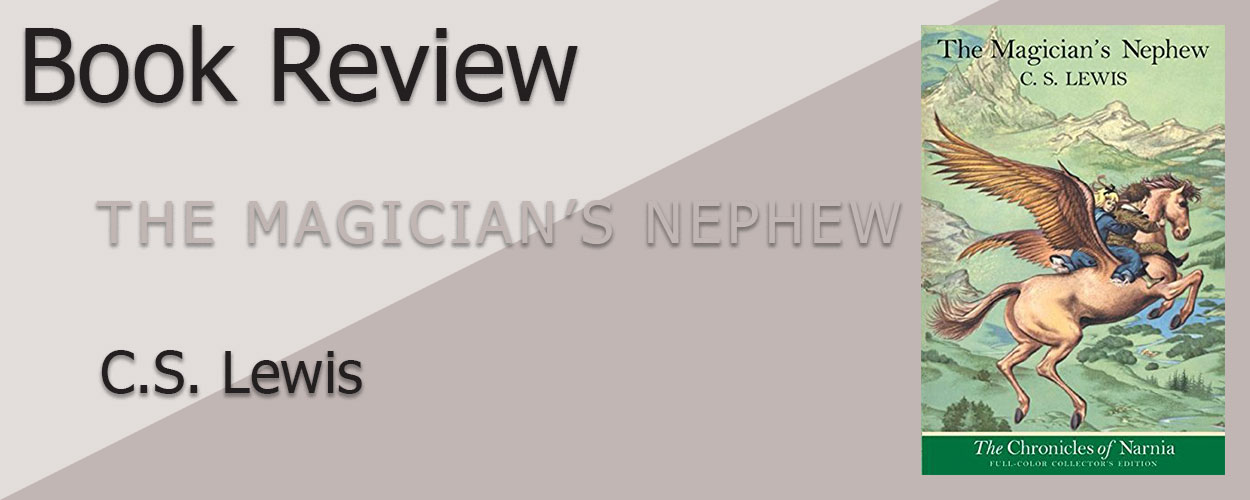

I really liked it
This is one of those series that you always hear about, but I never read it as a kid. I saw the movie years ago, though, so when I saw this whole illustrated boxed set at a used bookstore, I immediately got it!
Read: June 3 – June 8, 2024
Genre: Classic, Fairy Tale
Audience: Children
Book contains: Victorian typical behaviour, good vs evil
Purchase a copy from Amazon.ca
Because his mother is sick, Digory Kirke is staying with his aunt and uncle. He meets the neighbour, Polly, and as kids are wont to do, they begin exploring together. They accidentally stumble upon Digory’s uncle, a greedy man who uses them for one of his magical experiments. Things go wrong from there.
It’s called book one, but this book is sort-of a prequel and sort-of a standalone book. It gives a lot of the origins of what happens in the rest of the series: how Narnia came to be, how the Professor got the magical wardrobe, and the origins of the White Witch. It was a fun adventure!
C.S. Lewis writes in third person omniscient, which is common for fairy tales. He takes the role of the storyteller, sometimes speaking directly to the reader (especially when he makes a comment while shifting focus on the characters).
Since this is such a short book, I didn’t think to look up any readers and chose to just read it the old-fashioned way. It was quite relaxing, and it meant I could take my time looking at the full colour images.
Digory and Polly are the main characters in this fairy tale—two children who go on some otherworldly adventures because of Digory’s uncle, a magician. I liked the dynamic between the two children: they are a stereotypical boy-girl duo from the late 1800s, in which Polly is cross and “proper”, and Digory is reckless and adventurous though kind. The characters these two interact with the most are antagonists or—as children’s stories often portray—adults who are less than competent (thus leaving the children to solve the problem).
Some lessons taught through the connections built within this story are interesting and could be taken in a few different ways. A reader with a more negative view on that time period may think some of the things said are “out of date” and “inappropriate”, but I could also see it in a way that showed a view and allowed the reader to disagree with it. In these situations, it’s great for a parent reading this book to their child and discussing it with them. For example, the relationship between Digory and his uncle compared to his relationship with his mom or aunt.
The style of this book is very much like a fairy tale written for children, which I like. It is a bit too simplistic for my taste at times, but it’s also great for older readers who want to take a break in between more complex narratives.
The pacing was interesting. For the overall plot, it made sense, but I was expecting to get to Narnia a whole lot sooner, and then near the end, there was a set up for something to happen that took a lot less time than I anticipated (it wasn’t the main focus). Still, it was pretty good, and though I read this the old-fashioned way, it held my attention quite well.
Despite the period typical views, I highly recommend this series for kids to read. It’s an excellent classic, and book one is a good place to start!
The Chronicles of Narnia Book 1: The Magician’s Nephew by C.S. Lewis
The Chronicles of Narnia Book 2: The Lion, the Witch, and the Wardrobe by C.S. Lewis
The Chronicles of Narnia Book 3: The Horse and His Boy by C.S. Lewis
The Chronicles of Narnia Book 4: Prince Caspian by C.S. Lewis
The Chronicles of Narnia Book 5: The Voyage of the Dawn Treader by C.S. Lewis
The Chronicles of Narnia Book 6: The Silver Chair by C.S. Lewis
The Chronicles of Narnia Book 7: The Last Battle by C.S. Lewis
A Series of Unfortunate Events Book 1: The Bad Beginning by Lemony Snicket
Alice in Wonderland Book 1: Alice’s Adventures in Wonderland by Lewis Carroll
*The Wicket by Carlee Coton*
Coraline by Neil Gaiman
Tigerpetal Press is a small book press dedicated to publishing local authors and poets.